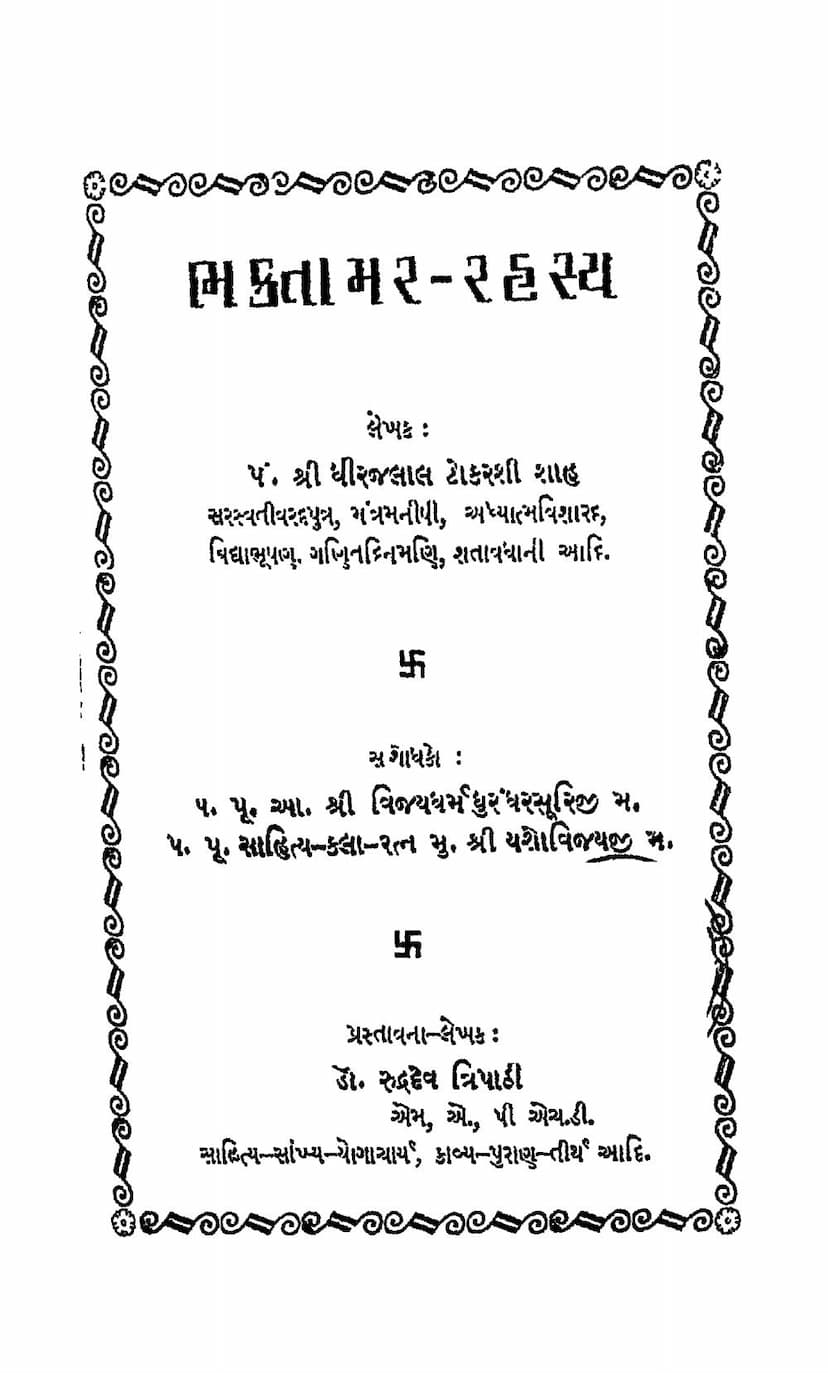Bhaktamara Rahasya
Added to library: September 1, 2025

Summary
Here's a comprehensive summary of the Jain text "Bhaktamara Rahasya" by Dhirajlal Tokarshi Shah, based on the provided pages:
Overview
"Bhaktamara Rahasya" is a comprehensive commentary and exploration of the famous Jain "Bhaktamara Stotra." Authored by Pt. Shriman Dhirajlal Tokarshi Shah, a renowned Jain scholar, mantra expert, and polymath, the book aims to delve into the esoteric secrets and profound significance of the Bhaktamara Stotra. Published by Jain Sahitya Prakashan Mandir, it is presented as a valuable resource for understanding and practicing the devotional verses of Acharya Manutung Suri.
Key Aspects and Content:
-
Author and His Credentials: Pt. Dhirajlal Tokarshi Shah is highlighted for his vast knowledge in spirituality, mantra science, and various scholarly fields. His expertise is evident in the depth of the analysis presented in the book.
-
Publisher and Support: Jain Sahitya Prakashan Mandir is credited with publishing the book, emphasizing their commitment to making significant Jain literature accessible. The book also acknowledges the support from individuals and institutions like Acharya Shrimad Vijaydharmadhurandharsurishwarji Maharaj, Muni Shrimad Yashovijayji Maharaj, Shri Amarchand Nahata, various Jain libraries, and the Bhandarkar Oriental Research Institute.
-
Dedication: The book is affectionately dedicated to Shri Narayanji Shamji Memaya, recognizing his philanthropic nature, scholarly pursuits, and dedication to Jainism. A detailed biographical sketch of Shri Memaya is included, highlighting his contributions to society, particularly his advocacy for cotton farmers and his deep engagement with Jain philosophy.
-
Structure of the Book: "Bhaktamara Rahasya" is structured into five distinct sections or 'khandas':
- First Khand (Preface/Introduction): This section lays the groundwork by introducing the importance of hymns and prayers, defining the term 'stotra,' outlining its various types, and explaining the paramount significance of the Bhaktamara Stotra within Jain tradition. It discusses the unique features of Jain stotras, such as the absence of eroticism and violence in their descriptions.
- Second Khand (Detailed Analysis of Bhaktamara Stotra): This is the core of the book, providing a verse-by-verse explanation of the Bhaktamara Stotra. Each verse is presented with its original Sanskrit text, followed by its grammatical breakdown (anvay), word-for-word meaning (shabdarth), overall meaning (bhavarth), and a detailed commentary (vivechan). This section aims to unlock the deeper layers of meaning within each verse.
- Third Khand (Maha Prabhavik Kathas - Glorifying Tales): This section comprises 28 narratives that illustrate the miraculous powers and efficacy of the Bhaktamara Stotra. These stories serve as testimonials to the stotra's ability to overcome obstacles, grant wishes, and provide protection. The book mentions that these stories are based on the commentary by Shri Gunakarsuri, with potential variations found in different traditions.
- Fourth Khand (Worship Rituals and Procedures): This section details the practical aspects of worshipping and utilizing the Bhaktamara Stotra, including daily rituals (nitya path), special observance rituals (akhand path), and specific mantras and 'vidyas' associated with each verse for achieving various purposes like protection, victory, knowledge, and removing obstacles. It also touches upon tantric practices and their significance in invoking divine energies.
- Fifth Khand (Poetic Review and Translation): This concluding section includes a poetic review of the stotra by Dr. Rudradev Tripathi and a parallel Gujarati translation of the Bhaktamara Stotra by the late Shri Mavji Damji Shah. It also contains appendices with illustrations (chitra) related to the stotra.
-
Historical Context and Origin: The book delves into the origins of the Bhaktamara Stotra, referencing the traditional account of Acharya Manutung Suri's release from imprisonment through the stotra's power. It also discusses scholarly debates regarding the stotra's authorship and its historical period, linking it to the 7th century CE and the court of King Harshavardhana. The text also addresses the differing verse counts (44 vs. 48) between Svetambara and Digambara traditions.
-
Literary and Scholarly Significance: The book highlights the Bhaktamara Stotra's profound literary merit, its influence on subsequent Jain literature (numerous commentaries and poetic adaptations), and its widespread popularity across different Jain sects and even beyond the Jain community. It emphasizes the stotra's blend of devotional fervor, philosophical depth, and poetic excellence.
-
Mantra and Tantra Connections: A significant aspect of the book is its exploration of the mantras and 'yantras' associated with each verse of the Bhaktamara Stotra. It provides specific 'mantras' for various purposes, emphasizing the importance of proper pronunciation, devotion, and adherence to ritualistic procedures for their efficacy. The book also offers guidance on mantra sadhana, including precautions and the need for spiritual purity.
-
Emphasis on Devotion and Faith: Throughout the text, a strong emphasis is placed on the power of unwavering faith and devotion ('shraddha') in achieving the stotra's benefits. The numerous anecdotes and the author's own scholarly approach underscore the belief that sincere devotion is the key to unlocking the stotra's true potential.
Overall Purpose:
"Bhaktamara Rahasya" serves as a guide for both scholarly study and spiritual practice related to the Bhaktamara Stotra. It aims to provide readers with a deep understanding of the stotra's meaning, its historical context, its literary beauty, and its practical application in life for spiritual growth and worldly well-being. The book is a testament to the enduring power and relevance of this ancient Jain devotional hymn.